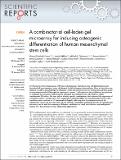A combinatorial cell-laden gel microarray for inducing osteogenic differentiation of human mesenchymal stem cells
Author(s)
Dolatshahi-Pirouz, Alireza; Nikkhah, Mehdi; Gaharwar, Akhilesh K.; Hashmi, Basma; Guermani, Enrico; Aliabadi, Hamed; Camci-Unal, Gulden; Ferrante, Thomas C.; Foss, Morten; Ingber, Donald E.; Khademhosseini, Ali; ... Show more Show less
DownloadDolatshahi-Pirouz-2014-A combinatorial cell-laden.pdf (9.426Mb)
PUBLISHER_CC
Publisher with Creative Commons License
Creative Commons Attribution
Terms of use
Metadata
Show full item recordAbstract
Development of three dimensional (3D) microenvironments that direct stem cell differentiation into functional cell types remains a major challenge in the field of regenerative medicine. Here, we describe a new platform to address this challenge by utilizing a robotic microarray spotter for testing stem cell fates inside various miniaturized cell-laden gels in a systematic manner. To demonstrate the feasibility of our platform, we evaluated the osteogenic differentiation of human mesenchymal stem cells (hMSCs) within combinatorial 3D niches. We were able to identify specific combinations, that enhanced the expression of osteogenic markers. Notably, these ‘hit’ combinations directed hMSCs to form mineralized tissue when conditions were translated to 3D macroscale hydrogels, indicating that the miniaturization of the experimental system did not alter stem cell fate. Overall, our findings confirmed that the 3D cell-laden gel microarray can be used for screening of different conditions in a rapid, cost-effective, and multiplexed manner for a broad range of tissue engineering applications.
Date issued
2014-01Department
Harvard University--MIT Division of Health Sciences and TechnologyJournal
Scientific Reports
Publisher
Nature Publishing Group
Citation
Dolatshahi-Pirouz, Alireza, Mehdi Nikkhah, Akhilesh K. Gaharwar, Basma Hashmi, Enrico Guermani, Hamed Aliabadi, Gulden Camci-Unal, et al. “A Combinatorial Cell-Laden Gel Microarray for Inducing Osteogenic Differentiation of Human Mesenchymal Stem Cells.” Sci. Rep. 4 (January 29, 2014).
Version: Final published version
ISSN
2045-2322